
Almost half of the Master Model Railroaders have earned the Chief Dispatcher certificate. This indicates that scheduled train operation is a high concern of the serious railroad modeler. In a survey of MMRs, in which 14 dispatchers replied, 10 earned their certificates on a home layout while the others did it at a club. It took about a year's time to acquire the hours.
There are several major obstacles in earning Dispatcher: access to a layout which has the track requirements, scheduling time with interested and qualified people, and the dreaded paperwork.
For reference: The NMRA website, Chief Dispatcher page contains the latest Achievement Program Dispatcher requirements, or you may obtain them, and the witness certified log sheet, from your divisional or regional AP Manager.
A good reference source on realistic operation is a 1977 soft-cover book from Kalmbach titled How to Operate Your Model Railroad (Out Of print) by Bruce Chubb, MMR which covers timetables, dispatching methods and all you need to know about this subject. It would be worth while finding a copy.
This article is composed from contributions by MMRs from five regions. It will provide you with a good cross section of operational thinking and helpful advice.
And now, let's hear from R.B. Trombley and Bill Bell, plus Bill Ackland, Don Manlick and Doug Smith.
First, a layout is needed, either home or club version with the basic requirements per Part A. If you don't have a home layout but are in the process of building or planning one, it would be wise to add the required features in the construction plans. Even if you are not interested now in dispatching, you may change your mind about operation in the future. (See track plan fig. 1). If you have a finished layout that is lacking some of the requirements, try to modify it by adding a mainline loop, point-to-point, or combination to make-up the minimum requirements. Scenery is not essential.
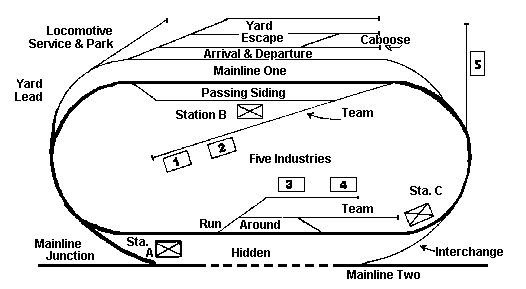
Figure 1. A simple trackplan containing all the requirements for two main lines without dual tracks. Operation for two - or three man crew with multiple job assignments using three locomotives: freight, passenger, and yard. The passenger train can be an RDC, a gas-electric, or a two-car consist.
If command control is not used, various electrical blocks will be needed for a minimum three-locomotive operation. It is better, however, to put in more than three blocks.
A club layout has all you need. If you don't know the location of clubs, including home operating groups, contact your local AP Manager. He will be able to help you. Also, he may give you some names of members who have the Dispatcher certificate and are willing to give you some advice on how they did it.
Once you have the layout, next is acquiring hours in the various job categories. The category descriptions have been clarified in the regulations. A certified log sheet of your experience must be verified after each session. You'll need someone, an NMRA member if possible, to witness and verify your job activity, time and date.
Each position is an exciting challenge. As time goes by, your skill level will improve in train handling. Also, controling scheduled train activity with different people always generates different action. Your technique of operation will develop a personal style. Imagination and fantasy will be a large part of the play.
It is recommended that each person should have a written copy of the "operator's instructions." Some call it a rule book for the layout you are using. This is valuable to clarify specific details and information so you don't have to memorize the different job aspects. This can be a two-page sheet to ensure conformity regarding train assignments, restrictions, track, industry, and station information; or it can be a multi-page "blow-by-blow" activity plan.
The method of time-keeping and clock ratio is up to you. You don't have to build a fast clock unless you want to.. (See Model Railroader, September 1983, page 66, and correction, November 1983, page 168.
Now for the paperwork: there are four things to do; first, drawing a layout schematic can be done with a computer or the old standby using a ruler, pencil, maybe a compass, a French curve or a track-planning template made by Pacific Rail Products, Hobby Craft Specialities, or CTT. A freehand drawing is acceptable.
On your illustrated track plan, identify different features, such as stations, industries and so on using a standard symbol with names or numbers to reference each item in the footnotes. You will need to draw the layout to a scale with simulated distances (SMILES=scale miles).
It is a good idea, but not essential, to include a sketch of your layout with track elevation and extra details to help AP Chairmen understand your set up. Adding creative elements using colored pens such as roads, shrubbery, trees, mountains, etc. is optional.
The second requirement, timetables and charts are fun (to some) and relatively easy to construct. How elaborate you want to go is an individual preference. For Part B-2, the schedule format can be done on a formal sheet (prototype style) or a display card. The important things are to show the train number, indicate direction, stops by town name and, of course, the times of departure and arrival at each station.
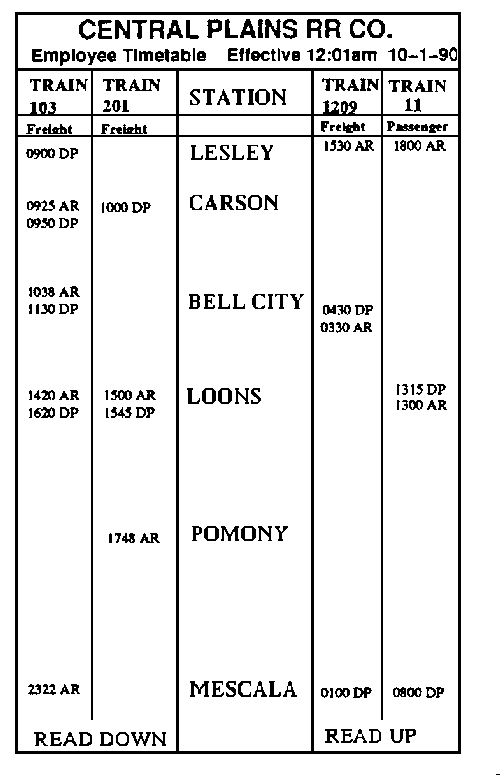
Figure 2. A timetable card by R.B. Trombley, dispatcher.
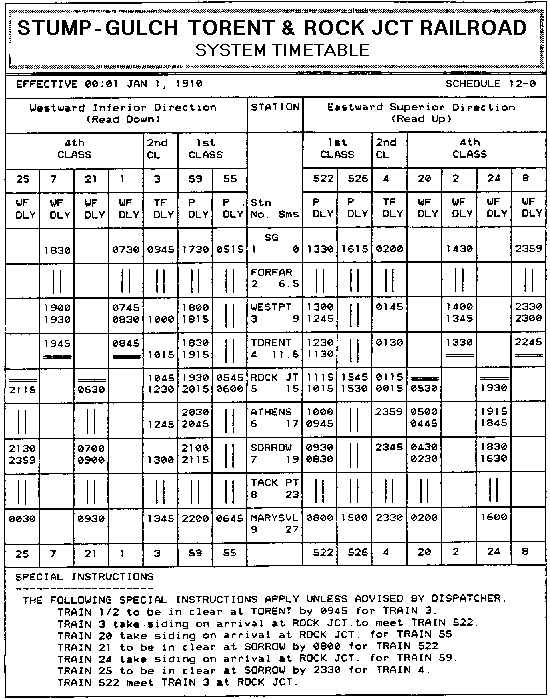
Figure 3. Timetable by Bill Ackland, dispatcher.
A train chart, the third requirement in Part B. shows a graph of the schedule. The train graph is a visual display of all the scheduled rail activity in this part of the railroad covered by the dispatcher. With a simple ruler and a pen or pencil, you can easily make a train graph. You can use a circle to show two trains meeting, then describe exactly how you will handle the meet, indicating arrival and departure times, movement necessary to avoid collisions, etc.
Using different colors is also something you can do to enhance your diagram.
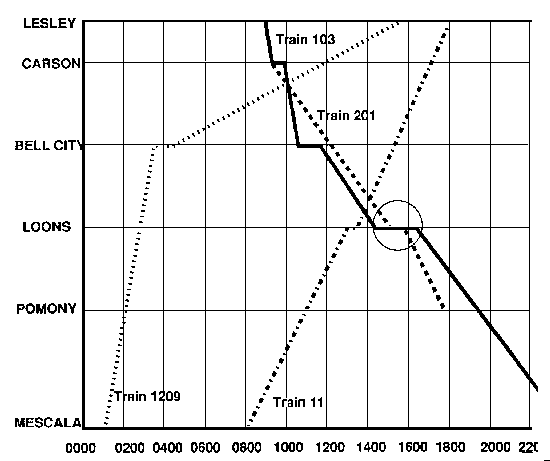
Note the busy activity from 9 a.m. to 6 p.m.-especially at 10 a.m. between Bell City and Carson, then it's "heads up" at 2 p.m. and a train meet (circled) at 3. Chart by R.B. Trombley.
This element, Part B 4, ranges from simple to complex. The easiest is the "tack and card."
Ed Ravenscroft, MMR #7 and the father of the Tack on Car System, explained his car marker method in Model Railroader magazine in July 1965. Using colored thumbtacks placed on cars in a drilled hole becomes a visual identification. It becomes easy to make-up trains using an index card with train and destination color coded, then follow and spot cars at industries with the same color reference.
Bill Bell uses a modified Ravenscroft card form on his Palouse & Pacific Railroad. The card shows all destinations to which the type of car might be sent and its destination is designated by one paperclip. The clip, when slanted, shows the car to be empty and, when straight across the card, to be full. The clip is moved only when a car is picked up and is considered to be empty if it arrived full and vice versa. All car cards have a category of LCL (less than carload), loading dock, hold for order, and house track. This allows them to move to any stop on the railroad. Cars which are "open for use" with "No Destination" should have the paperclip straight across the car type. This gives the next main yard cars for reserve use.
Each engineer/conductor must recognize the responsibility to act as ordering and shipping representative for the industries, yard master for local yards and incorporate an awareness of the operating potential and needs of the entire railroad.
Douglas Smith, MMR #1, produced tape/slide program TSI, titled "How I Run My Railroad." This audiovisual clinic, revised in 1981, covers way freight and passenger train operation and switching using two types of card order systems.
A photo essay of his layout was published in The Saturday Evening Post in May 1960.
Doug suggested adding a team track at each station for drop off and pick-up passenger head-end cars and freight cars (including LCL) for off track and out-of-sight industries. This allows for flexible operation, odd loads, and the feeling of the prototype.
Don Manlick, on his Crystal Rock & Northern, uses a card and waybill system similar to one described in Railroad Model Craftsman, February 1978. CR&N employee duties cover job descriptions and detailed responsibilities for all aspects of scheduled operations, extra trains, accidents, derailments, and car movements. Their traffic manager is called a car distributor. He is the only one to handle all car cards.
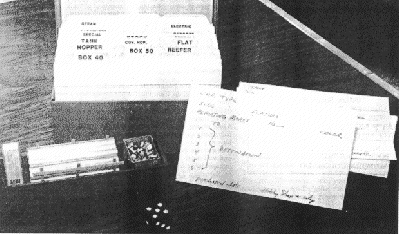
Mike Collins, on his Central Renn Valley Railroad, uses a modified card determined by a throw of a die (for the gambler in you).
Trombley's method uses a computer program to generate a manifest switchlist for train numbers, road and engine numbers, car pick-up and drop info. With a little electronic wizardry, a wheel report lists the RR, car type, number, current city/industry, destination city/industry for the operating session. If you are interested in computerized operation, there is a special interest group (SIG).
Getting people together may be difficult. A reasonable schedule needs to be determined, otherwise it will take a long time to acquire the hours of experience. Bill Ackland, president of the Stump-Gulch Torent & Rock Junction Raftroad, suggests weekly sessions if possible so you don't forget the operating rules, learn and earn quicker, cross-train in all the jobs, and use the time to simulate real situations and functions. Bill feels, since the entire crew development and education takes so much time, along with worksheets, forms and schedules, every member should submit the paperwork for Dispatcher. A nice group goal to achieve, besides the benefit you get in friendship and fellowship.
When submitting the paperwork, even though it is not required, a railroad biographical sketch is usually included. Some dispatchers also include some photos of the crew in action with extra description of the theory of operation, rules, documents and dispatching aids. These extra items along with your Statement of Qualification (SOQ) and necessary paperwork ensures compliance and makes it easier for the Achievement Program Chairmen to understand and verify your qualifications.
NOTE: In closing, if all this sounds complicated, it can be, if you want simulated realistic operation in model railroading and not just running trains. However, if you are mainly interested in earning the Chief Dispatcher certificate, stick to the minimum requirements only. It really isn't that difficult.